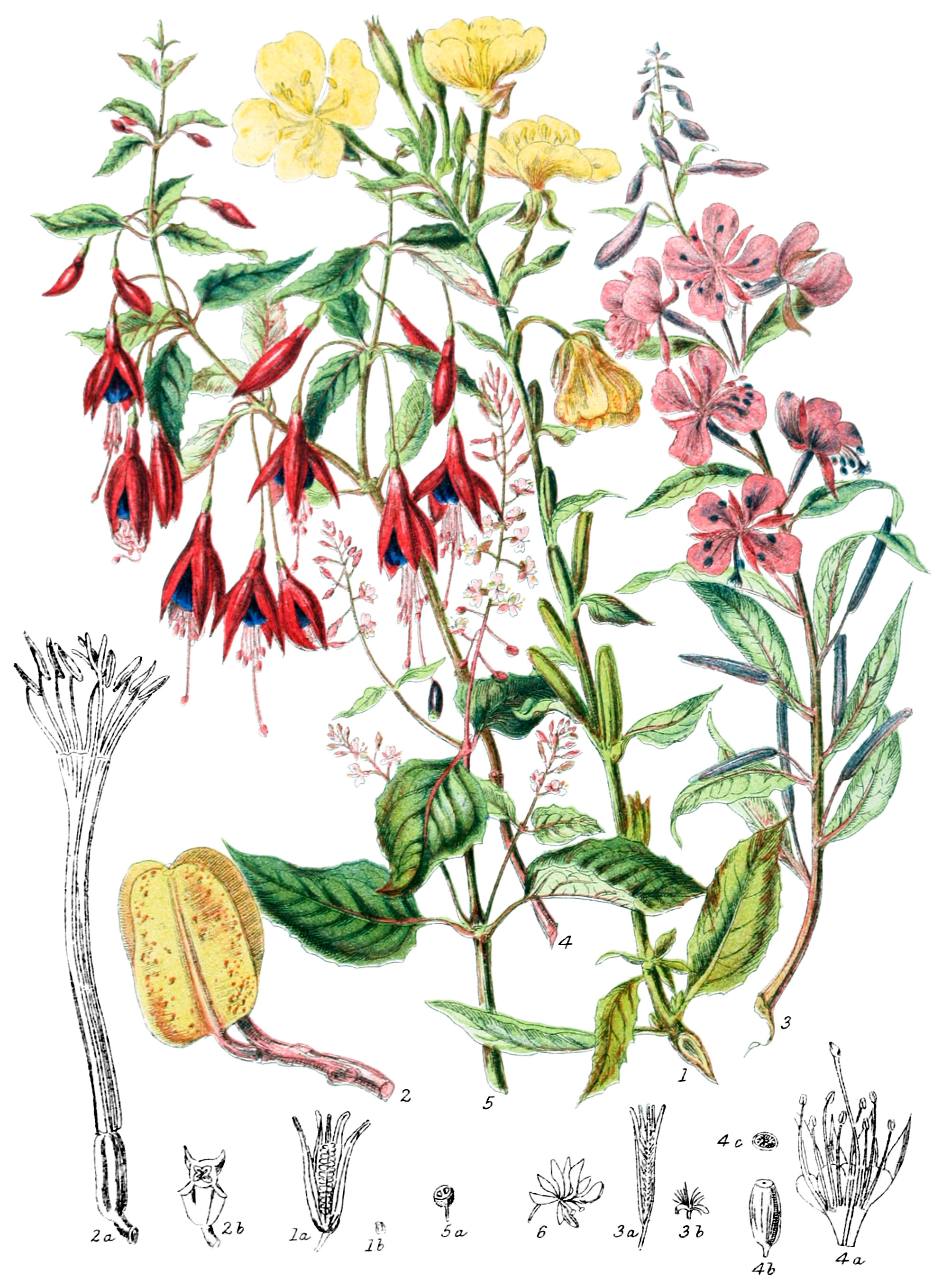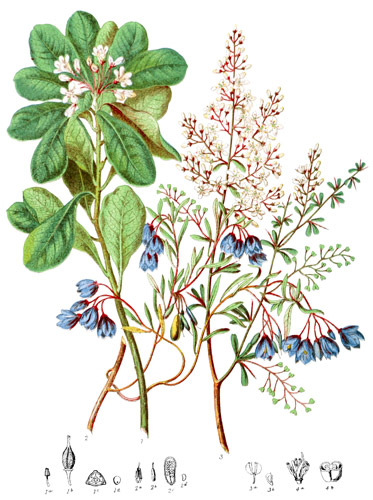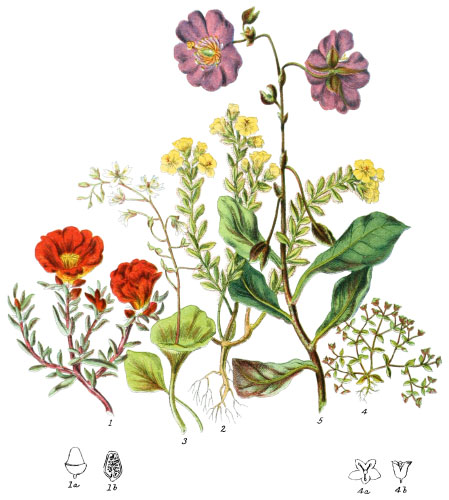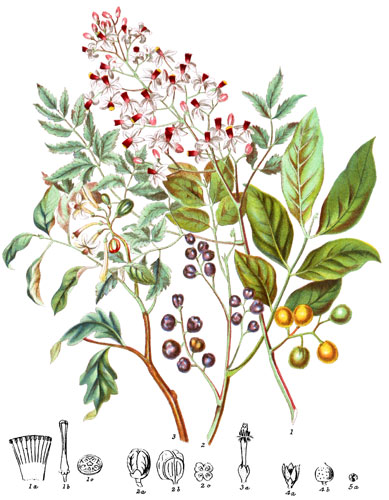Key characteristics
Shrubs and herbaceous plants, the leaves are alternate or opposite, simple, entire or toothed at the edge. The flowers are either on terminal or side branches of various forms and colours; the calyx is above the ovary, tubular, the upper part divided into four segments, or two, as in Circæa (5)*, closed in a valvular form in the bud, cohering to the points, clinging together in two pair after the flower is expanded. The petals are generally equal in number to the lobes of the calyx, into the throat of which they are inserted, of a regular shape, twisted in the bud; in Skinnera the petals are wanting. The stamens are four or eight, in Circæa two, in Lopezia (6) one stamen only is perfect with an anther, the other is in the form of a spoon-shaped petal. The style is along and slender, the stigma either four-lobed or round-topped. The fruit is a capsule or a berry, with four or two cells, containing numerous seeds without albumen, sometimes bearded; Circæa has only one seed in each cell.
The succulent fruit of Fuchsia connects these plants with the Myrtle tribe, but the want of pellucid dots and their definite stamens clearly distinguish them.
Slight mucilaginous properties prevail throughout the Tribe, and some species are astringent.
Select plants in this order
Not all plants listed are illustrated and not all plants illustrated are listed.
- Œnothera opens its flowers only towards sunset, and has therefore been called the Evening Primrose, and given the name to the whole tribe; Onagra is a synonym of French botanists.
- O. biennis (1) grows on the sandy coast of Lancashire, where it is supposed to have been originally transported across the Atlantic; it is also found in Suffolk, and on the banks of the Arrow, in Warwickshire. The stem grows to two or three feet in height, often branched and leafy, rough, with the beautiful though short-lived yellow flowers continuing to come forth in succession every evening during the summer, and being delicately fragrant. The method of expansion of the petals is extremely curious. The calyx parting at the sides, shows them twisted within; when they have acquired sufficient vigour to force asunder the points of the calyx hooked together, it falls downwards in two pairs, and the petals gradually expand and spread out flat; in the course of the next morning they wither. The tapering root serves as food to the peasants in some poor countries. This is the only British species, but many others are natives of America and the Cape of Good Hope.
- O. macrocarpa (2) has large and brilliant flowers, and a remarkable seed-vessel, with four wide wings at the angles; the stems are recumbent, and will cover a large space of ground; in the extreme length of the slender pistil we are minded of some of the Cactus flowers.
- Epilobium is a genus common in England, adorning our meadows and river banks in various parts, existing here in its greatest perfect; one species alone is a native of the Andes, of no beauty of growth or colour.
- E. villosum belongs to the Cape, and E. coloratum to North America.
- E. angustifolium (3) is our most elegant species, found frequently in the north of England and south of Scotland, as well as in other localities near the Thames and elsewhere. It is generally to be seen in gardens near London, where it flourishes extremely well.
- E. alpinum grows on Ben Lomond and other Scotch mountains, as well as E. alsinfolium, which forms extensive tufts with its creeping roots.
- To the genus Fuchsia, named after a famous German botanist, Fuchs, we are highly indebted for the ornament of gardens of all classes; the humblest cottage in the remotest village may possess plants of the once rare but now abundant Fuchsia coccinea (4) flowering abundantly throughout the summer. It was first brought from Chile in 1788; since that time several other species have been discovered, and varieties raised. The wooded ravines and moist banks of rivers amongst the Andes are the chief situations where they flourish, being suited to those shady damp regions, whilst the Cactus plants abound in the dry districts of the Cordillera.
- On the wooded slopes of the Pichincha, at 13,000 feet elevation, where the air is usually filled with mist, Fuchsia triphylla displays its numerous large scarlet flowers of remarkable brilliancy. The berry of some species attains a moderate size, and is eatable; that of F. fulgens, from† Mexico, has rather a pleasant sub-acid flavour when made into tarts.
- Clarkia pulchella is a favourite in gardens, introduced of late years from North America.
- Isnardia is a small plant growing in marshes from Holstein to Geneva.
- Jussiæa is scarcely worthy of recording the name of three celebrated brothers who rendered essential service to botany; some species belong to South America; one appears with its yellow flowers in the rice-fields of the Khasya mountains of India, at an elevation of 2800 feet.
- Circæa is said to have been named by the Greeks after the enchantress Circe; it grows usually in moist shady places, and the different species have minute delicate flowers.
- C. lutetiana (5) has been found also in Nepal.
Locations
This Tribe inhabits chiefly the Temperate parts of the world, especially of America; a large number of species belong to Europe, some to India; in Africa, they are less abundant, being nearly confined to the Cape, except Jussiæa, which inhabits other parts of that continent.
Legend
- Œnothera binnis, Evening Primrose. England.
- Capsule.
- Seed.
- Œnothera macrocarpa, Large-fruited Œnothera. Missouri.
- Pistil and Stamens.
- Section of Ovary.
- Epilobium angustifolium, Rose-bay, or Willow-herb. England.
- Capsule.
- Feathered Seed.
- Fuchsia coccinea, Scarlet Fuchsia. Chile.
- Flower opened.
- Berry.
- Section.
- Circæa* lutetiana, Enchanter’s Nightshade. England.
- Section of Seed-vessel.
- Lopezia coronata.
- Circæa was spelled as “Circea“ in the key chararistics and legend in the original description.
- †“from” was spelled as “ftom” in the original description.
Explore more
Posters
Decorate your walls with colorful detailed posters based on Elizabeth Twining’s beautiful two-volume set from 1868.
Puzzles
Challenge yourself or someone else to assemble a puzzle of all 160 botanical illustrations.





